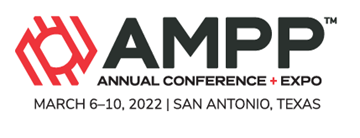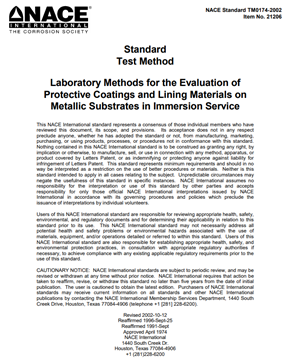Search
Coatings and Linings
View as
Sort by
Display
per page
The Use of Coatings for Corrosion Control on Offshore Oil Structures
Product Number:
41206-219-SG
Publication Date:
2006
$20.00
Thickness Does Matter - The Use of Thick Linings In Industrial Applications
Product Number:
41205-186-SG
Publication Date:
2005
$20.00
Third Generation Polysiloxane Coatings For Elevated Temperature; Field Performance
Product Number:
51322-18044-SG
Publication Date:
2022
$20.00
Titans of the Abyss: Polyurethane, Polyurea and Hybrid Lining Technology
Product Number:
41213-773-SG
Publication Date:
2013
$20.00
TM0105-2018, “Evaluation of Coatings Containing Conductive Carbon Additives for Use as an Anode on Atmospherically Exposed Reinforced Concrete”
Product Number:
21247-SG
ISBN:
1-57590-200-1
Publication Date:
2018
$109.00
TM0105-HD2016, “Evaluation of Coatings Containing Conductive Carbon Pigmentation for Use as an Anode on Atmospherically Exposed Reinforced Concrete”
Product Number:
21247-HD2016
ISBN:
1-57590-200-1
Publication Date:
2016
$179.00
TM0112-2018-SG, Test to Determine the Potential Corrosion Effects of Ballast Water Treatment Systems on Ballast Tanks Coating and Other Materials
Product Number:
21258-SG
ISBN:
1-57590-254-0
Publication Date:
2018
$109.00
TM0112-HD2012-SG, Test to Determine the Potential Corrosion Effects of Ballast Water Treatment Systems on Ballast Tanks
Product Number:
21258-HD2012
ISBN:
1-57590-254-0
Publication Date:
2012
$179.00
TM0174-1991, Laboratory Methods for the Evaluation of Protective Coatings Used as Lining Materials In Immersion Service
Product Number:
53021-HD1991
Publication Date:
1991
$179.00
TM0174-2002, Laboratory Methods for the Evaluation of Protective Coatings and Lining Materials on Metallic Substrates in Immersion Service
Product Number:
21206-SG
Publication Date:
2002
$179.00
TM0174-HD1996-SG Laboratory Methods for the Evaluation of Protective Coatings and Lining Materials in Immersion Service-HD1996
Product Number:
21206-HD1996
Publication Date:
1996
$179.00












